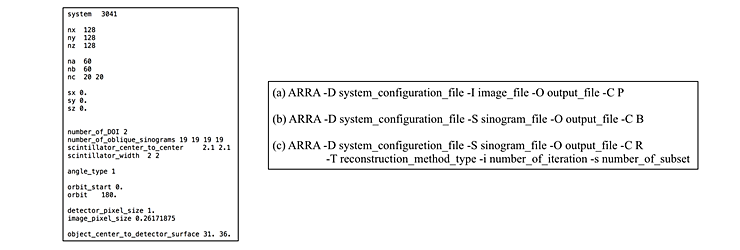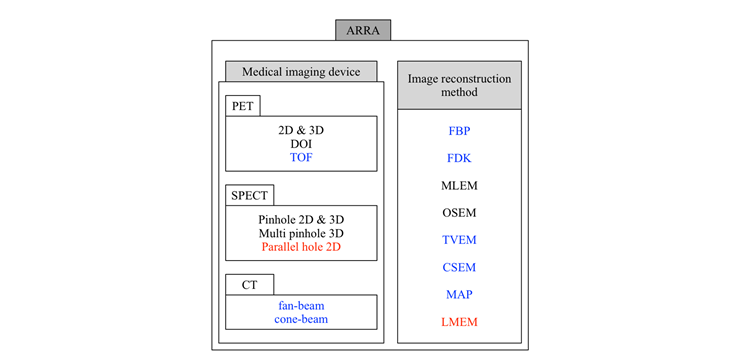ONGOING PROJECTS
- Development of Remote Radiation Detection Imaging System Mounted on a Drone
- High Resolution SPECT using Variable Pinhole Collimator
- Positioning Algorithm for CZT Virtual Frisch-grid Detector
- Multi-purpose Super-resolution Gamma Detector
- Multi-pinhole SPECT
- Low Profile Light Guide using Diffusion Film
- Advanced Reconstruction for Radiation imaging (ARRA)
COMPLETED PROJECTS
- Reconstruction of Dose Distribution in In-beam PET for Carbon Theraphy
- Image Registration for Breast Cancer Study
- High Energy Collimator Design for I-131
- Plasma-Display-Panel based X-ray Detector (PXD)
- CCD based Gamma Camera
- Abdomen Registration for PET/CT and MR images
- Performance Optimization by Patient Dose Analysis and Image Quality Assessment in CT Fluoroscopy
- Cone-beam based system matrix for a pixelated SPECT detector
- Development of Time-of-Flight Method for Improvement of Signal-to-Noise Ratio
Advanced Reconstruction for Radiation imaging (ARRA)
This study was developed as part of the SPECT study in the Advanced Reconstruction for Radiation imaging (ARRA) project.
ARRA is an image reconstruction solution that embraces all medical imaging devices that require image reconstruction such as PET, SPECT, and CT, and provides various image reconstruction methods. The concept of ARRA is designed so that the desired researchers can apply it to their research without special entry barriers. ARRA can be used regardless of the computing environment or method, and can be easily applied to the desired system through various parameters implementing the detector system.
ARRA classifies the detection environment into four digits according to the medical imaging device or system model simulation method. The first digit specifies the dimension, 2-dimensional is denoted by 2, and 3-dimensional is denoted by 3. The second digit categorizes the medical imaging device, and the third categorizes the simulation method of the system model. The fourth digit increases from 1 to the system version. Figure 1 shows the structure of the system numbers.

Fig. 1. Structure of system numbers
Each system has a system configuration file that reflects the characteristics of the medical imaging device. The system configuration file contains all parameters for ARRA to simulate the detection environment and to compute the system matrix. The system configuration file includes parameters for the geometry of the detection environment and the drive method of the detector, and it includes special parameters depending on the system.
Figure 2, left shows the system configuration file for the 3041 system, an image reconstruction system for PET. It consists of basic information such as the structure and geometry of image voxels and sinograms and special parameters needed for image reconstruction such as Depth-Of-Intrinsic (DOI).

Fig. 2. Example of PET's system configuration file (left), and ARRA execution command structure: (a) projection, (b) back-projection, and (c) image reconstruction (right).
ARRA is designed to utilize the desired image reconstruction method on any system by completely separating the computation of the system matrix and the image reconstruction method. The system configuration file only provides the parameters needed to compute the system matrix. Image reconstruction method types and parameters are entered as command line parameters.
ARRA performs projection, back-projection, and image reconstruction according to the command line parameters. The types of image reconstruction methods that are currently developed are limited to MLEM and ordered-subset expectation maximization (OSEM). In the future, various image reconstruction methods such as filtered back projection (FBP) and total variation regulated expectation maximization (TV-EM) will be added.
Figure 2, right shows the ARRA projection, back-projection, and image reconstruction commands. The basic structure of the execution command classifies the type of the parameter, such as -X, and inputs the value of the parameter after the blank. Parameters such as D, I, S, and O associated with the file input the path of the corresponding file. C selects the method to be driven by variables such as P, B, and R; respectively, projection, back-projection, and image reconstruction. T selects the type of image reconstruction. Currently available variables are MLEM and OSEM. i and s specify the number of repetitions and the number of subsets.
The conditions for using ARRA projection, back-projection, and image reconstruction are to create a system configuration file according to the detection environment and to input a command using parameters of image reconstruction. Figure 3 shows the types of medical imaging devices and image reconstruction methods applied to ARRA. The black ones have been developed, the red ones are under development, and the blue ones are going to be developed.

Fig. 3. ARRA's medical imaging device and image-reconstruction method types
Participating Researchers

